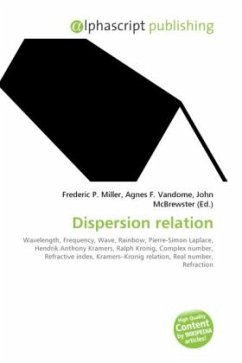
Dispersion relation
Versandkostenfrei!
Versandfertig in 6-10 Tagen
36,99 €
inkl. MwSt.

PAYBACK Punkte
18 °P sammeln!
Dispersion relations describe the ways that wave propagation varies with the wavelength or frequency of a wave. This variation has long explained how white light is dispersed into different colors, thus making rainbows possible. It turns out, thanks to the wave nature of all traveling objects, that dispersion relations are key to understand how energy and objects are transported from point to point in any medium. This story likely began, however, with interest in the dispersion of waves on water for example by Pierre-Simon Laplace in 1776. Important clues to the wide-ranging utility of dispers...
Dispersion relations describe the ways that wave propagation varies with the wavelength or frequency of a wave. This variation has long explained how white light is dispersed into different colors, thus making rainbows possible. It turns out, thanks to the wave nature of all traveling objects, that dispersion relations are key to understand how energy and objects are transported from point to point in any medium. This story likely began, however, with interest in the dispersion of waves on water for example by Pierre-Simon Laplace in 1776. Important clues to the wide-ranging utility of dispersion relations came from work in the early 20th century by H. Kramers and R. Kronig. Their relations take the form of integrals relating the real and imaginary parts of a property, called the complex refractive index, of any medium in which waves travel. The real part of this index describes how waves of different frequency refract (change speed and hence bend or disperse) through different angles on entering the medium. The imaginary part of the index describes how the wave is absorbed in the medium.












